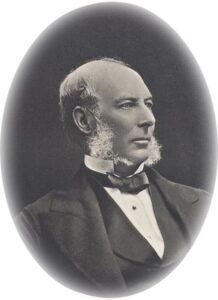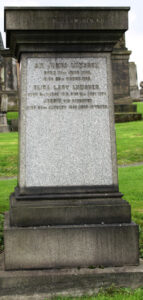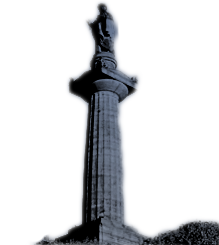Robert Stewart Laidlaw
Tuesday, October 29th, 2024Sir James Lumsden (1808-1879)
Sunday, November 12th, 2023
by Colin Campbell
The son of a previous Lord Provost of the City, James Lumsden was born in 1808. After attending the Glasgow Grammar School (now High School), he matriculated at Glasgow University in 1861, followed by training in a city “Counting House”. In 1843 he entered his father’s business which was a big supplier of stationery. He travelled extensively on Company business in the 1830’s.
In 1835 he married Eliza Pinkerton; they were to have three daughters and one son.
In 1860 he was elected Lord Dean of Guild of the Merchants’ House. He became member of the Town Council and was elected to the post of Lord Provost from 1866 until 1869.
His business interests were wide. He was a Director of the Glasgow and South Western Railway from 1849, (Chairman in 1871) and a Director and Chairman of the Clydesdale Bank.
In 1867 he was appointed Deputy Lieutenant of Lanarkshire and in 1869 a Deputy Lieutenant of Dunbartonshire.
He played host to the Prince and Princess of Wales when they visited Glasgow to lay the foundation stone of the new Glasgow university in 1868. He entertained them the following day to a Civic Lunch. He was subsequently knighted in commemoration of that visit.
He had a town house at 194 Bath Street and 1867 he acquired the estate of Arden on the western shores of Loch Lomond and constructed Arden House one of the biggest mansions in the west of Scotland.
He died on 22 March 1879; his wife having died the previous year. Both he and his wife are buried in the Lair in Compartment Omega along with a daughter, Jessie, 15 years old.
(Ack: One Hundred Glasgow Men (image), the Glasgow University Story, ScotlandsPeople)
Catherine Lang
Saturday, March 20th, 2021Profile provided by Keith Clark, descendant of Catherine Lang
Father: Gabriel Lang
Mother: Elisabeth Paterson
Birth: 6 Feb 1813 in Houston, Renfrew, Scotland
Death: 16 Sept 1859 Glasgow, Scotland
Marriage: William Wilson – 10 June 1836 in Houston, Renfrew, Scotland
Children: Gabriel Wilson; Janet Wilson; William Wilson
As with any story about a person several generations removed, the narrative can only reconstruct historical events. As you read about Catherine pause to consider how, as a young child growing up on a miller’s farm, she must have seen her world; how she felt as a young woman of 23 when she fell in love; and how she reacted to being a new mother at age 25. How did she feel as she moved around a rapidly changing Scotland in the 1840’s leaving family and friends behind? And how was Catherine affected as her illness slowly moved her toward an altered reality.
Catherine Lang and her husband William Wilson were born when the rural country farm life they knew as children was being superseded by the rise of industry, cheap labour and crowded towns that lacked infrastructure. The story of their early lives follows what must have been a familiar tale for many rural Scottish families. The transition from the country life to life in a town dominated by iron works and other factories was probably difficult for the couple to make.
Catherine was born into a family that was recorded as having lived in Renfrewshire since at least the 1700’s. She was born in Houston, Renfrewshire on 6 Feb 1813 to Gabriel Lang and Elisabeth Paterson.[i] Her father was a miller at the Barochan Mill[ii] and must have been in this occupation for most of his working career[iii]. We know little about Catherine’s life at this time, except that she worked as a farm servant in her father’s house[iv].
Working at Towncroft farm, just one kilometre north of the Barochan Mill on the Barochan Road, was a young man, William Wilson of about the same age. Somehow they met and William Wilson and Catherine Lang were married in Houston on 10 June 1836[v]. The young couple settled in the nearby town of Paisley. By 1841 two of their three children had been born; Gabriel in 1838 and his sister Janet in 1840. The 1841 census gives William’s occupation as a cowfeeder[vi] . This was an urban occupation as cows were kept in byres in town to provide a supply of milk to townspeople before the rural dairying industry, reliant on the developing railways, became fully established. The Fowler’s Commercial Directory of 1841-42 shows the family living at 60 Canal Street and William working as a grocer, carter and cowfeeder.[vii] While still living in Paisley, Catherine had their third child, William, in 1843.
But times were changing in Paisley. At the turn of the 19th century Paisley’s home industries were focused on the production of silk gauze, lawn and linen gauze, muslin and white sewing thread.[viii] By 1840, when William and Catherine were living there, small manufacturing was replaced by mining and iron smelting with 42,000 tons of coal being mined from one area shaft alone in1845.[ix]
Catherine and her family gave up Paisley and moved to the Dalmellington area in Ayrshire sometime after 1846, presumably so her husband would find work in the newly established blast furnaces of the region. The 1851 census shows that the family resided at 35 Waterside Village in the Parish of Dalmellington. [x] Waterside village was a new village that grew around the original iron works which were built between 1846 and 1856 and had been created to house workers who came to the Doon Valley to work at the Dalmellington Iron Company.[xi] Like William, these workers came from many areas of rural Scotland lured by employment in the mills. By 1851 there were 89 houses in the village. In 1851, Catherine’s husband William worked as a carter, possibly for the iron works of the area.[xii] Catherine would be working in the house raising her three children. Within six years, life for this family would be shattered.
On 16 March 1858 Catherine was admitted to the Glasgow Royal Asylum for Lunatics at Gartnavel.[xiii] Her admissions report stated that that she had worked as a farm servant, that she could read, and that prior to the illness she was able to discharge ordinary domestic duty.[xiv] It further attested that insanity was not hereditary in her family and that her mental illness had begun fourteen months earlier with no definite cause. She had been occasionally suicidal and sometimes dangerous to others. Her symptoms included a tottering gait, a stutter and talking in a childish, imbecilic manner. She imagined that her children were all dead, that she was pregnant and had many delusions about possessing great wealth and many fine clothes. The doctors diagnosed her as having an illness known then as general paralysis. This 19th century diagnosis is now known to have been made for tertiary syphilis or neurosyphilis.[xv]
An insight into the family’s financial status in 1858 is provided in Catherine’s asylum admission papers. The answer to the question “Parish to which the Lunatic (if a Pauper) is Chargeable” is answered by “Dalmellington Parish”. The account book of the asylum lists her as a pauper and the charges (£1.9s.6d/week) for her board were charged back to Dalmellington Parish.
The case register [xvi] shows that during the first two months of her stay at Gartnavel she was “incontinent in a particularly filthy way”. As part of her treatment her hair was shaved off and an enema was administered daily. During the summer of 1858 her bodily health improved but her mind remained very feeble. By October she had a “contented and cheerful disposition”. In December she was recorded as frequently saying “I’m goin’ home today”.
In the spring of 1859 Catherine was still in Gartnavel and her bodily health began to decline. By August she was confined to bed. Despite attentive nursing she developed bed sores and was given the use of a water bed. On 16 September 1859 she died of “general paralysis”.[xvii] Her 45 year old husband William was now a widower and her 18 year old unwed daughter Janet was four months pregnant and living at home with him. Catherine is buried in the Glasgow Necropolis in a common grave in Compartment Eta.[xviii]
On 25 July 1861, Catherine’s husband William, and 44 year old Isabella Barrie,[xix] were wed in a Presbyterian church service in the Parish of Carluke in Lanark.[xx] William and Isabella left Newmains with its iron works and moved to the countryside where he found work on a farm. The census of 1871 shows the family living on a farm in rural Cambusnethan and William employed as a bower.[xxi] He had finally returned to his first love and occupation; that of farming. Isabella listed her occupation as a bower wife and they had one domestic servant, Marion Gilchrist, age 22, living with them. Isabella died on 13 October 1888. Eight days after the death of his second wife, on the morning of 21 October 1888, in Cambusnethan, William died at age 72 of bronchitis.[xxii] His occupation on his death registration is “Dairyman”. It is not known where he is buried.
[i] 06/02/1813 Lang, Catherine (Old Parish Register Births 565/00 0010 0191 Houston) www.scotlandspeople.gov.uk
[ii] Fowler’s Commercial Directories of Renfrewshire 1829 to 1837
[iii] 1859 Wilson, Catherine (Statutory registers Deaths 646/2 203) www.scotlandspeople.gov.uk On this, her death registration, her father’s occupation is listed as miller. Her mother is not known.
[iv] Petition To The Sherriff To Grant Order For The Reception Of A Patient Into An Asylum Dated 8 March 1858 Reference MC2/3 No. 4162; Index, Scottish Indexes (http://www.scottishindexes.com/mctranscript.aspx?mcid=3063); Original Source: Mental Health Records, National Records of Scotland, Edinburgh, Scotland.
[v] 10/06/1836 Wilson, William (Old Parish Register Marriages 565/00 0020 0229 Houston)
[vi] Census of Scotland 1841 573/00 010/00 00 High Parish of Paisley
[vii] Fowler’s Commercial Directories https://www.nls.uk/family-history/directories/post-office/index.cfm?place=renfrewshire
[viii] http://www.electricscotland.com/history/statistical/The_statistical_account_of_Scotland1.pdf
[ix] New Statistical Account of Scotland 1845 http://www.electricscotland.com/history/statistical/volume7.htm
[x] Census of Scotland Piece SCT1851 Place: Ayr – Ayrshire ED: 1 Civil Parish: Dalmellington Village: Dalmellington Folio: 0 Page 24 Schedule 69 Address: 35 Waterside Village
[xi] “Waterside, another hamlet owned by the Dalmellington Company, lies three miles off.” http://www.scottishmining.co.uk/405.html
[xii] A carter was a driver of (horse-drawn) vehicles for transporting goods. Carters were often employed by railway companies for local deliveries and collections of goods and parcels much like a modern day van driver. A carter typically drove a light two wheeled carriage. http://rmhh.co.uk/occup/c.html
[xiii] Notices of Admissions by the Superintendent of Mental Institutions, Gartnavel Royal Asylum, Lanarkshire, NRS Reference MC2/3 No. 4162; Index, Scottish Indexes (http://www.scottishindexes.com/mctranscript.aspx?mcid=3063); Original Source: Mental Health Records, National Records of Scotland, Edinburgh, Scotland.
[xiv] Surgeon’s Case Notes for Catherine Lang/Wilson, Gartnavel Asylum, page 116
[xv] General paralysis of the insane was widely held to be the “one absolutely hopeless disease” of the nineteenth century asylum, “which, being once recognised, the patient’s doom (was) held to be sealed”. The general symptoms of the disease “exhibiting one or more of the disease’s telltale signs: grandiose delusions, a staggering gait, disturbed reflexes, asymmetrical pupils, tremulous voice, and muscular weakness” match the symptoms that Catherine presented with. General paralysis of the insane is a syndrome of mental disorder and weakness occurring in tertiary syphilis and is also known as symptomatic neurosyphilis. It is a rare disease in western general adult psychiatry in the 21st century but, at the height of its occurrence, it is thought that it accounted for up to 20% of patients in asylums. For a full discussion of the disease in 19th Scottish Asylums, consult: The most deadly disease of asylumdom: general paralysis of the insane and Scottish psychiatry, c.1840–1940 by G Davis, Wellcome Lecturer in the History of Medicine, School of History, Classics and Archaeology, University of Edinburgh, UK http://www.rcpe.ac.uk/sites/default/files/davis.pdf . Another good discussion of the disease from The British Psychological Society is found at https://thepsychologist.bps.org.uk/volume-25/edition-10/looking-back-fascinating-and-fatal-disease .
[xvi] Catherine’s complete medical records; Application for Admission to Gartnavel, Medical Reports and Surgeon’s Notes have been obtained by the author of this document. The narrative here is based on those notes.
[xvii] 1859 Wilson, Catherine (Statutory registers Deaths 646/2 203) www.scotlandspeople.gov.
[xviii] Email from Morag T Fyfe, Historical and Genealogical Researcher, Friends of Glasgow Necropolis, www.glasgownecropolis.org/research-assistance/
[xix] The date of her birth is difficult to establish. On her marriage certificate she gives her age as 45, making her born in 1816, on the census of 1881 her age is given as 63 meaning she was born in 1818 while on her death registration her age is stated as 71 meaning she was born in 1817.
[xx] 1861 William Wilson (Statutory registers Marriages 629/30 www.scotlandspeople.gov.uk
[xxi] The use of the word bower as an occupation is not common. It is derived from Bow, a stock or herd of cattle, especially cows. Bower is a term used in Ayrshire, Lanarkshire and Kirkcudbrightshire meaning a tenant who hires cattle and grazing rights on land. As well, a Bower of Cows can be an alternate term for a Dairyman. This occupation was used in the 1851 census for Ayreshire, Scotland where William’s occupation is listed as “Dairy Man or Bower of Cows”. Whatever term is used, William was back on a farm with cows.
[xxii] 1888 Wilson, William (Statutory registers Deaths 628/325) www.scotlandspeople.gov.uk. There are several interesting things on his death registration. In early censuses William is referred to as cowfeeder (stockman or cattleman) but that changes to carter and general contractor as stated in later censuses and on his marriage certificate for Isabella. In 1888 his wife Isabella’s death registration lists his occupation as cowfeeder and his own death registration lists his occupation as dairyman. His daughter Janet’s death registration gives her father’s occupation as dairyman. If nothing else, we can assume that even though he moved into and worked around the industrialized area of Cambusnethan, he remained a farm person at heart.











